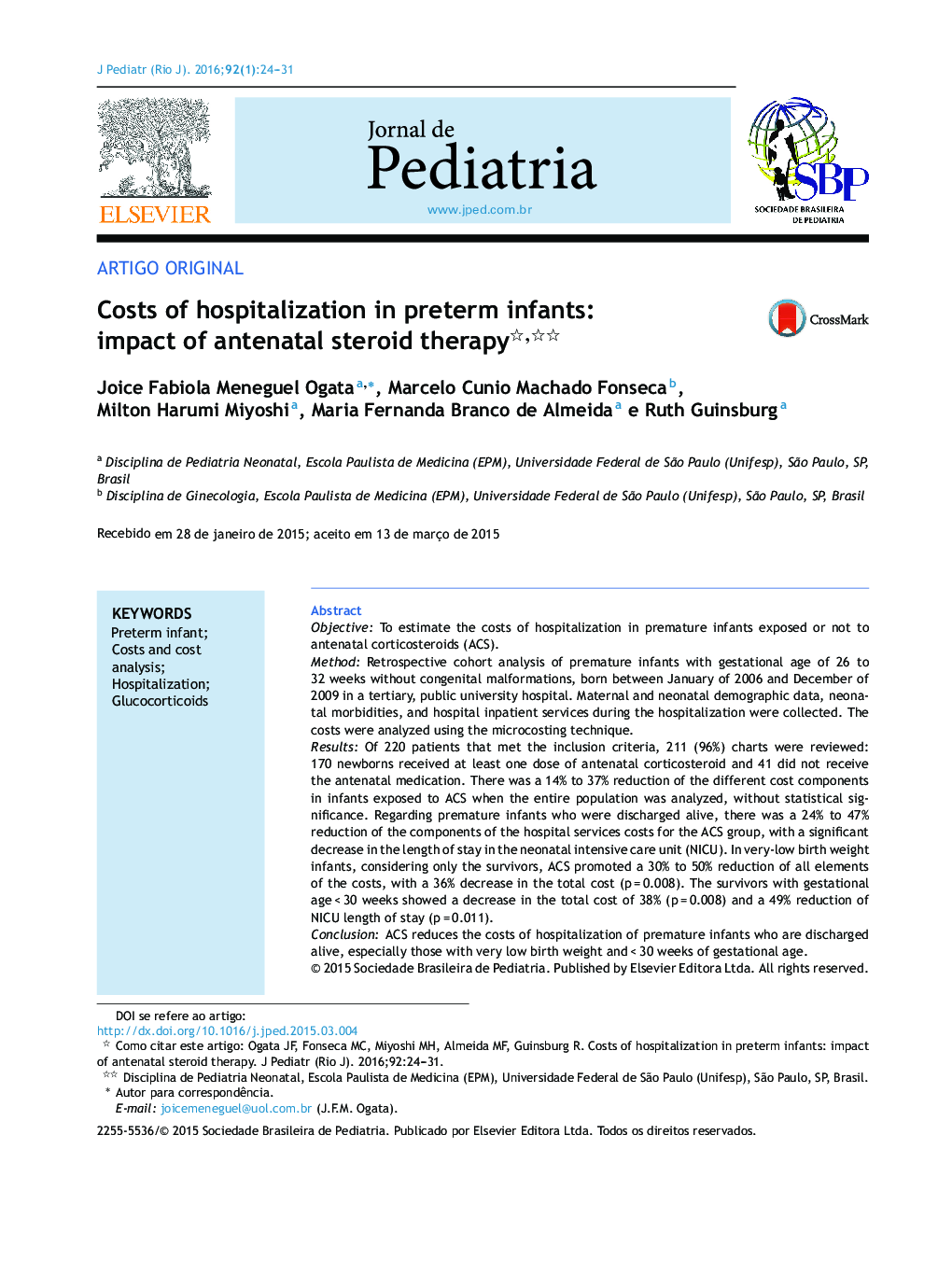| Article ID | Journal | Published Year | Pages | File Type |
|---|---|---|---|---|
| 4154300 | Jornal de Pediatria (Versão em Português) | 2016 | 8 Pages |
ObjectiveTo estimate the costs of hospitalization in premature infants exposed or not to antenatal corticosteroids (ACS).MethodRetrospective cohort analysis of premature infants with gestational age of 26 to 32 weeks without congenital malformations, born between January of 2006 and December of 2009 in a tertiary, public university hospital. Maternal and neonatal demographic data, neonatal morbidities, and hospital inpatient services during the hospitalization were collected. The costs were analyzed using the microcosting technique.ResultsOf 220 patients that met the inclusion criteria, 211 (96%) charts were reviewed: 170 newborns received at least one dose of antenatal corticosteroid and 41 did not receive the antenatal medication. There was a 14% to 37% reduction of the different cost components in infants exposed to ACS when the entire population was analyzed, without statistical significance. Regarding premature infants who were discharged alive, there was a 24% to 47% reduction of the components of the hospital services costs for the ACS group, with a significant decrease in the length of stay in the neonatal intensive care unit (NICU). In very‐low birth weight infants, considering only the survivors, ACS promoted a 30% to 50% reduction of all elements of the costs, with a 36% decrease in the total cost (p = 0.008). The survivors with gestational age < 30 weeks showed a decrease in the total cost of 38% (p = 0.008) and a 49% reduction of NICU length of stay (p = 0.011).ConclusionACS reduces the costs of hospitalization of premature infants who are discharged alive, especially those with very low birth weight and < 30 weeks of gestational age.
ResumoObjetivoEstimar os custos da internação hospitalar de prematuros cujas mães receberam ou não corticoide antenatal (CEA).MétodoCoorte retrospectiva de prematuros sem malformações congênitas com idade gestacional de 26 a 32 semanas, nascidos entre janeiro/2006 e dezembro/2009, em hospital público, terciário e universitário brasileiro. Coletaram‐se dados demográficos maternos e dos recém‐nascidos (RN), a morbidade neonatal e o uso de recursos de saúde durante a internação hospitalar. Os custos foram analisados pela técnica de microcosting.ResultadosDos 220 nascidos que obedeciam a critérios de inclusão, 211 (96%) prontuários foram revisados: 170 receberam CEA e 41 não receberam a medicação. Analisando‐se toda a população, houve redução de 14‐37% entre os diferentes componentes do custo nos pacientes expostos ao CEA, sem significância estatística. Na análise de prematuros que receberam alta hospitalar vivos, o grupo com CEA teve redução de 24‐47% nos vários componentes dos custos hospitalares, com diminuição significativa dos dias de internação em terapia intensiva. Os nascidos com peso < 1.500 g, considerando‐se somente os sobreviventes, são aqueles que mais se beneficiaram da administração do CEA, com redução significativa de todos os componentes dos custos em 30‐50%, diminuição de 36% no custo total (p = 0,008). Para o grupo com idade gestacional < 30 semanas, também sobreviventes, houve diminuição do custo total de 38% (p = 0,008) e redução de 49% dos dias de internação em UTI neonatal (p = 0,011).ConclusõesO CEA reduz o custo hospitalar de prematuros que sobrevivem à internação após o parto, principalmente naqueles abaixo de 1.500 g e 30 semanas de idade gestacional.
